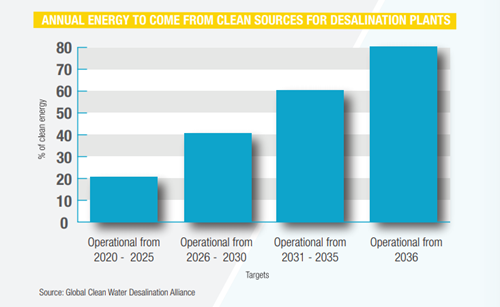The urgency for water desalination
Around the world, an average of 80 - 100 gallons of water are consumed daily per capita with this number predicted to rise significantly in the coming years with the UN indicating global population to grow a further 13.2% by 2030, to reach a total of 8.6 billion.
Water desalination has long been utilised as a key solution to bridge the gap between water demand and supply. The process of desalination involves a process to separate salt from sea water to produce drinking water. This process is currently providing 90 million m3 of water a day and one of the biggest consumers is here in the Middle East, which accounts for more than 40% of the world’s water desalination capacity, with Saudi Arabia and the UAE ranking among top producers. [1[i]]
Water desalination is an energy intensive process. Huge strides are being made in the production process to utilize renewable energy resources to serve as an optimum substitute to powering desalination plants.
Renewable energy and water desalination
Innovative technology drives the future of desalination, moving towards a more efficient and sustainable production with the help of renewables. Frequently used technologies to desalinate water include thermal desalination: Multistage Flash Evaporation (MSF) and Multi Effect Desalination (MED); and single-phase membrane processes: Reverse Osmosis (RO) and Electrodialysis (ED).
Understanding the type of energy each technology requires is crucial in determining the apt renewable source and depends on a number of factors including [2]:


Below are the possible combinations of renewable energy resources suitable for each desalination process:

Around 70% of desalination in the GCC is currently done through thermal processes which require energy in the form of heat and electricity. Solar thermal or geothermal resources would serve as the ideal renewable energy resources to power those plants.
Alliances such as the Global Clean Water Desalination Alliance are investigating and promoting clean energy sources for desalination. The organisation has set several global targets till 2036 to provide a continually increasing percentage of clean energy to power desalination plants. The goal is to have 80% of renewable resources as the main provider of energy for desalination by 2036 [1].

The shift to renewable energy sources to power desalination plants serves as the ideal sustainable alternative and a lucrative economic investment as renewable energy sources are decreasing in cost. Although only 1% of renewable-based desalination is deployed (as of 2015) [3], the future holds a promising and affective integration amongst renewables and desalination.
[1]: Energy Efficient Desalination: Meeting the GCC’s water needs in an environmentally sustainable way report. Available at: https://www.internationalwatersummit.com/__media/Energy-Efficient-Desalination-2018.pdf
[2]: Renewable Energy Opportunities in Water Desalination report. Available at: https://pdfs.semanticscholar.org/fa7f/1cc48e2e2f10104b7a6fa659b55cb84bbcfd.pdf
[3]: Economics of Renewable Energy for Water Desalination in Developing Countries. Available at: https://www.omicsonline.org/open-access/economics-of-renewable-energy-for-water-desalination-in-developing-countries-2162-6359-1000305.php?aid=66724

Stay updated and receive news